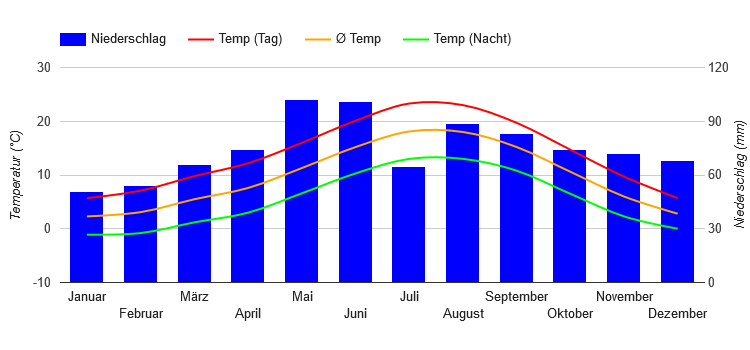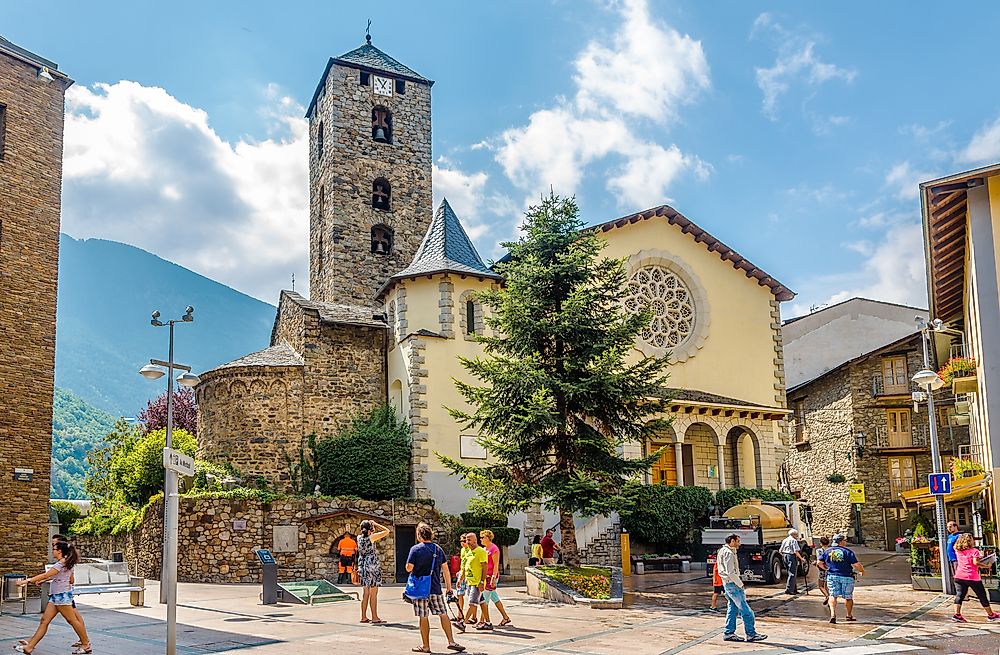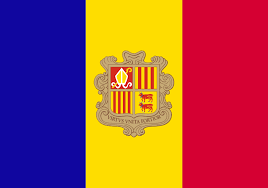Population: 77,281 (2016)
Area: 467.63 km2
Andorra is the sixth-smallest nation in Europe, having an area of 468 km2 (181 sq mi) and a population of approximately 77,281. Andorra is the 16th-smallest country in the world by land and 11th-smallest country by population. Its capital Andorra la Vella is the highest capital city in Europe, at an elevation of 1,023 meters (3,356 feet) above sea level. The official language is Catalan, although Spanish, Portuguese, and French are also commonly spoken.
Andorra’s tourism services an estimated 10.2 million visitors annually. It is not a member of the European Union, but the euro is the official currency. It has been a member of the United Nations since 1993. In 2013, the people of Andorra had the highest life expectancy in the world at 81 years, according to the Global Burden of Disease Study.
Physical geography
Due to its location in the eastern Pyrenees mountain range, Andorra consists predominantly of rugged mountains, the highest being the Coma Pedrosa at 2,942 metres (9,652 ft), and the average elevation of Andorra is 1,996 metres (6,549 ft). These are dissected by three narrow valleys in a Y shape that combine into one as the main stream, the Gran Valira river, leaves the country for Spain (at Andorra’s lowest point of 840 m or 2,756 ft). Andorra’s land area is 468 km2 (181 sq mi).
Phytogeographically, Andorra belongs to the Atlantic European province of the Circumboreal Region within the Boreal Kingdom. According to the WWF, the territory of Andorra belongs to the ecoregion of Pyrenees conifer and mixed forests.
Climate

Andorra has an alpine climate and continental climate. Its higher elevation means there is, on average, more snow in winter, lower humidity, and it is slightly cooler in summer.
Economy
Tourism, the mainstay of Andorra’s tiny, well-to-do economy, accounts for roughly 80% of GDP. An estimated 10.2 million tourists visit annually, attracted by Andorra’s duty-free status and by its summer and winter resorts.
One of the main sources of income in Andorra is tourism from ski resorts which total over 175 km (109 mi) of ski ground. The sport brings in over 10 million visitors annually and an estimated 340 million euros per year, sustaining 2,000 direct and 10,000 indirect jobs at present since 2007.
The banking sector, with its tax haven status, also contributes substantially to the economy (the financial and insurance sector accounts for approximately 19% of GDP). The financial system comprises five banking groups, one specialised credit entity, 8 investment undertaking management entities, 3 asset management companies and 29 insurance companies, 14 of which are branches of foreign insurance companies authorised to operate in the principality.
Agricultural production is limited, only 2%of the land is arable, and most food has to be imported. Some tobacco is grown locally. The principal livestock activity is domestic sheep raising. Manufacturing output consists mainly of cigarettes, cigars, and furniture. Andorra’s natural resources include hydroelectric power, mineral water, timber, iron ore, and lead.
Andorra is not a member of the European Union, but enjoys a special relationship with it, such as being treated as an EU member for trade in manufactured goods (no tariffs) and as a non-EU member for agricultural products. Andorra lacked a currency of its own and used both the French franc and the Spanish peseta in banking transactions until 31 December 1999, when both currencies were replaced by the EU’s single currency, the euro. Coins and notes of both the franc and the peseta remained legal tender in Andorra until 31 December 2002. Andorra negotiated to issue its own euro coins, beginning in 2014.
Andorra has traditionally had one of the world’s lowest unemployment rates. In 2009 it stood at 2.9%.
Andorra has long benefited from its status as a tax haven, with revenues raised exclusively through import tariffs. However, during the European sovereign-debt crisis of the 21st century, its tourist economy suffered a decline, partly caused by a drop in the prices of goods in Spain, which undercut Andorran duty-free shopping. This led to a growth in unemployment. On 1 January 2012, a business tax of 10%was introduced, followed by a sales tax of 2% a year later, which raised just over 14 million euros in its first quarter.
On 31 May 2013, it was announced that Andorra intended to legislate for the introduction of an income tax by the end of June, against a background of increasing dissatisfaction with the existence of tax havens among EU members. The announcement was made following a meeting in Paris between the Head of Government Antoni Marti and the French President and Prince of Andorra, François Hollande. Hollande welcomed the move as part of a process of Andorra “bringing its taxation in line with international standards”.
Population
The population of Andorra is estimated at 77,281 (2016). The population has grown from 5,000 in 1900.
Two-thirds of resident lack Andorran nationality and do not have the right to vote in communal elections. Moreover, they are not allowed to be elected as prime minister or to own more than 33% of the capital stock of a privately held company.
Languages
The historic and official language is Catalan, a Romance language. The Andorran government encourages the use of Catalan. It funds a Commission for Catalan Toponymy in Andorra (Catalan: la Comissió de Toponímia d’Andorra) and provides free Catalan classes to assist immigrants. Andorran television and radio stations use Catalan.
Because of immigration, historical links, and close geographic proximity, Spanish, Portuguese and French are also commonly spoken. Most Andorran residents can speak one or more of these, in addition to Catalan. English is less commonly spoken among the general population, though it is understood to varying degrees in the major tourist resorts. Andorra is one of only four European countries (together with France, Monaco, and Turkey) that have never signed the Council of Europe Framework Convention on National Minorities.
Religion

The population of Andorra is predominantly (88.2%) Catholic. Their patron saint is Our Lady of Meritxell. Though it is not an official state religion, the constitution acknowledges a special relationship with the Catholic Church, offering some special privileges to that group. Other Christian denominations include the Anglican Church, the Unification Church, the New Apostolic Church, and Jehovah’s Witnesses. The small Muslim community is primarily made up of North African immigrants. There is a small community of Hindus and Bahá’ís, and roughly 100 Jews live in Andorra. (See History of the Jews in Andorra.)
Healthcare
Healthcare in Andorra is provided to all employed persons and their families by the government-run social security system, Caixa Andorrana de Seguretat Social (CASS), which is funded by employer and employee contributions in respect of salaries. The cost of healthcare is covered by CASS at rates of 75% for out-patient expenses such as medicines and hospital visits, 90% for hospitalisation, and 100% for work-related accidents. The remainder of the costs may be covered by private health insurance. Other residents and tourists require full private health insurance.
The main hospital, Meritxell, is in Escaldes-Engordany. There are also 12 primary health care centres in various locations around the principality.
Transport
Until the 20th century, Andorra had very limited transport links to the outside world, and development of the country was affected by its physical isolation. Even now, the nearest major airports at Toulouse and Barcelona are both three hours’ drive from Andorra.
Andorra has a road network of 279 km (173 mi), of which 76 km (47 mi) is unpaved. The two main roads out of Andorra la Vella are the CG-1 to the Spanish border, and the CG-2 to the French border via the Envalira Tunnel near El Pas de la Casa. Bus services cover all metropolitan areas and many rural communities, with services on most major routes running half-hourly or more frequently during peak travel times. There are frequent long-distance bus services from Andorra to Barcelona and Toulouse, plus a daily tour from the former city. Bus services are mostly run by private companies, but some local ones are operated by the government.
There are no airports for fixed-wing aircraft within Andorra’s borders but there are, however, heliports in La Massana (Camí Heliport), Arinsal and Escaldes-Engordany with commercial helicopter services and an airport located in the neighbouring Spanish comarca of Alt Urgell, 12 kilometres (7.5 miles) south of the Andorran-Spanish border. Since July 2015, Andorra–La Seu d’Urgell Airport has operated commercial flights to Madrid and Palma de Mallorca and is the main hub for Air Andorra and Andorra Airlines.
Nearby airports located in Spain and France provide access to international flights for the principality. The nearest airports are at Perpignan, France (156 kilometres or 97 miles from Andorra) and Lleida, Spain (160 kilometres or 99 miles from Andorra). The largest nearby airports are at Toulouse, France (165 kilometres or 103 miles from Andorra) and Barcelona, Spain (215 kilometres or 134 miles from Andorra). There are hourly bus services from both Barcelona and Toulouse airports to Andorra.
The nearest railway station is L’Hospitalet-près-l’Andorre 10 km (6 mi) east of Andorra which is on the 1,435 mm (4 ft 8 1⁄2 in)-gauge line from Latour-de-Carol (25 km or 16 mi) southeast of Andorra, to Toulouse and on to Paris by the French high-speed trains. This line is operated by the SNCF. Latour-de-Carol has a scenic 1,000 mm (3 ft 3 3⁄8 in) metre gauge trainline to Villefranche-de-Conflent, as well as the SNCF’s 1,435 mm gauge line connecting to Perpignan, and the RENFE’s 1,668 mm (5 ft 5 21⁄32 in) -gauge line to Barcelona. There are also direct Intercités de Nuit trains between L’Hospitalet-près-l’Andorre and Paris on certain dates.














